Eating is one of the best parts about travel in Romania. The country has a revealing cuisine that sheds light on local life, history and tradition.
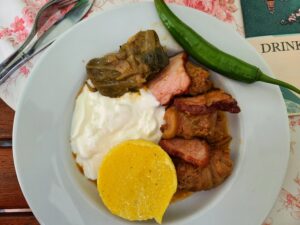
Romania’s geography – this is mentioned further in our Romania Travel Guide for backpackers and first-time visitors – is also a huge part of the local cuisine. The seasonal climate is great for growing an assortment of food. A LOT of it. To name a few, Romania is one of the world’s top producers of corn, wheat, sunflower seeds, plums and grapes.
Eating in Romania is a fun tour through the country’s culture and history, and your travel menu should include several essential basics and an extra taste beyond. This comprehensive Romania food guide will help you get a thorough sample of the country one bite at a time!
Contents
What is Romanian Food?
Romanian food is good. While that is the most important note for the Hangry Backpacker, the study of local food is fascinating and enlightening.
Understanding what you’re eating and where it comes from (literally and historically) is a great way to understand the place in which you’re traveling.
Romanian cuisine may not be complex in creation the way that French food is, for example, but the accompanying history is far from simple.
History & Influences
Romanian food is a vivid reflection of its past. With a history of aggressive neighbors and shifting populations, the food has a variety of outside elements and traits that come together to make something unique and distinct.
The present-day borders of Romania have seen centuries of foreign invaders and occupiers. From the Russian Empire, Habsburgs, Poles, Ottomans and so on, the territories within modern-day Romania have been under control of, and influenced by, dozens of foreign powers.
While foreign occupiers left flavors and recipes behind (among other things), the various ethnic groups to call Romania home are more visible in the cuisine. Modern-day Romania is the result of three historic regions (Transylvania, Wallachia and Moldavia) unifying to make one state.
These regions have been home to several notable ethnic groups, including sizable populations of Hungarians, Germans, Ukrainians and Poles.
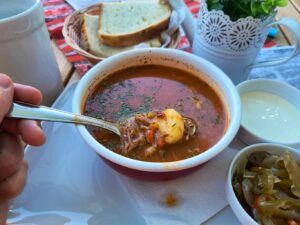
Each of these eras and ethnic groups made an impact on Romanian food as it is today. Some of the impact is visible, while much of it blends together to create the present-day cuisine.
For instance, the region of Transylvania is historically German and Hungarian. Food with Hungarian roots remains a common sight on menus despite most of the ethnic Hungarian population assimilating or emigrating over the past century.
Other notable influences stem from centuries of Ottoman occupation. Sarmale is one of the most well-known and popular Romanian dishes, but the origin is Turkish. Even the name comes from the Turkish word ‘sarma.’
Not every dish in Romania is foreign in origin, and you don’t have to spend hours researching the origins of every meal. That’s something I enjoy and am happy to share. But it is a fun way to learn and tour the history of the country.
Structure
The traditional Romanian diet is fairly simple and straightforward: meat; dairy; grains. This is an oversimplification, of course, but it’s the basic foundation of a traditional Romanian meal.
Eating local food in Romania typically involves a plate with meat (usually pork or cured sausage), dairy (sour cream or cheese) and some kind of starchy grain. Strangely (to me), it is often served with a fresh pepper that unpredictably ranges from mild to super spicy.
A typical Romanian breakfast is on the simple side. Common breakfasts consist of eggs, toast with jam, covrigi and perhaps some cured meats.
Traditional lunch in Romania does not vary much from breakfast. Lunch often includes something like a sandwich or polenta with cured meat or cheese.
Dinner is generally the largest meal of the day in Romania. Expect a hearty meal, and expect dinner to last a while. Especially when dining out, I noticed local Romanians sitting, eating, drinking, smoking and talking for a long time.
Meals vary depending on location in Romania. In rural areas, food is more traditional. Rural workers are also likely to eat heavier breakfasts and drink a bit more than their urban counterparts.
Holidays
As a very religious country, holidays, feasts and fasts of the Romanian Orthodox Church play a big part in what’s on the menu.
Christmas and Easter, in particular, are a time when seasonal foods make a widespread appearance. Christmas is the season for lots of pork and cozonac, a sweet bread. Around Easter, drob (a sort of lamb haggis) and pasca (a sweet, creamy and cheesy pie) are traditional foods to eat in Romania.
Most of the year falls under various fasting periods of the Romanian Orthodox Church. These are vegetarian fasts. There’s no need to worry, though! You can still satisfy your carnivorous cravings during these fasts.
Eating Vegetarian in Romania
We usually don’t highlight vegetarian or vegan eating at the Hangry Backpacker. However, when something is local, we have to mention it!
Most well-known traditional Romanian food is not vegetarian. There is a lot of food in the country that is vegan-friendly, though.
The aforementioned fasts in the Romanian Orthodox Church are not only vegetarian fasts. They are usually vegan, and menus across the country cater to the devout population.
The word you herbivores are looking for is ‘post.’ In Romania, post means fast, which equates to vegan food. Even if you aren’t practicing in the Romanian Orthodox Church, employ use of this word to comfortably find all the local rabbit food you can eat.
Must-Try Famous Romanian Dishes
Covrigi
Traditional eating in Romania begins each day with covrigi. It’s a light, tasty thing that’s easy to eat on the go.
What is covrigi? It’s basically a Romanian pretzel. It’s also not a pretzel. By that, I mean, locals don’t call it a pretzel – it’s covrigi.

Even though it is shaped like a pretzel and baked like a pretzel, it’s technically not. Walk like a duck, talk like a duck, must be a duck, right? Well, covrigi is not from pretzel dough, so therein lies the small distinction.
Anyway, this not-a-pretzel pretzel is a simple bread that is topped with sunflower seeds or poppy seeds. Covrigi is a great choice to eat breakfast like a local, especially urban-living Romanians looking for a quick bite on the go.
Covrigi is really cheap and sold pretty much everywhere. My favorite part is eating the leftover sunflower seeds that fall off the pretzel – I mean, not-a-pretzel.
Mici
Mici is one of the most well-known things to eat in Romania. Your Romanian travel menu is not complete without sampling mici on a few occasions.
This grilled sausage is small, hand rolled and has no casing. Mici is popular as a snack or meal. It is typically served with mustard and bread.

I ate a lot of mici in Romania. I’m sure inadequate mici exists – perhaps my palate is not refined to Romanian standards – but I enjoyed it every time.
Personally, I find mici to be very Balkan in nature. However, when I mentioned to a local that it was similar to chevapi (a popular grilled sausage in the Balkans), my comparison was not received well. I meant no offense, but it is similar. No matter. If you like chevapi, you will love mici.
Sarmale
This is another classic staple of traditional Romanian cuisine that is a must-try when you travel to this country. Sarmale is also an excellent example of foreign influence on Romanian cuisine.
Sarmale is, simply, cabbage rolls stuffed with meat and spices. Specifically, it is fermented cabbage leaves stuffed with a mixture of minced pork, rice, onions and seasonings. Most common seasonings are thyme, bay leaves and a touch of dill.
Traditional sarmale in Romania is cooked with bacon (pork belly) and sauerkraut in large batches in a single dish. Portions are usually 3-5 rolls, accompanied by a healthy dollop of sour cream, polenta and, once again, that possibly-spicy-but-maybe-mild green pepper.

Sarmale sometimes uses grape leaves in place of cabbage leaves. For this version, look for the word vita on the menu. While I love the more common version with cabbage leaves, the version with grape leaves is outstanding.
The origins of sarmale are very Middle Eastern/Turkish. What makes it uniquely Romanian is the minced pork, pork belly and the cabbage wrappings.
Mămăligă
Mamaliga is essentially polenta. Polenta is a staple of Romanian cuisine. Your travel menu anywhere in Romania will, inevitably, include eating plenty of polenta.
From a historical standpoint, polenta in this region of Europe likely dates back to Ancient Roman times of eating other grains in slop-form. When corn was introduced to Europe, the version of polenta we know today (from corn) became a staple food. It provides a lot of sustenance and energy for poor workers in a simple, cheap dish. And Romanian agricultural lands are excellent for corn production.

For many Westerners in the 21st Century, polenta is not the most appealing food. It looks simple, like grainy yellow slop, and isn’t bursting with flavor.
Personally, it reminds me of grits, which is extremely similar. As an American southerner and Louisianian, I would happily eat grits every day. However, grits are not as common outside of the Southern USA (especially in the Pacific Northwest, where I currently live), so I was enthusiastic about my mamaliga eating in Romania.
Most of your polenta encounters in Romania will come in the form of a simple side item. It’s not flashy, but it’s filling. Add a touch of salt and pepper and it’s good. Mix in some sour cream and throw in some meat or peppers (or hot sauce, if that is available) – now we’re talking.
Bulz
Bulz is Romanian polenta (mamaliga) that is dressed up to make a delicious full meal. This is a common dish across Romania, but it’s one of those foods that is never the same. Every restaurant and every grandmother has a unique rendition of the traditional Romanian meal.
With a base of polenta, bulz typically adds meat and a lot of cheese. An egg usually tops the dish. Eating in Romania is never complete without sour cream, so expect that, too.

Bulz is a heavy meal. Even what may appear as a smaller portion can be a gut bomb. It’s not the healthiest meal, but it is good. If you are planning a big hike or a night of partying, bulz is a decent base for your endeavors.
Sausage
Pork is the most commonly eaten meat. Cured meats are also popular across the country, eaten as part of breakfast or lunch, as appetizers or snacks.

I enjoyed every slice of sausage I tasted. Some of the flavors are quite unique, too, though it was more of a pointing-and-guessing game for me. Local varieties of salami are commonplace and easy to find, even in small convenience stores.
Cheese
Cheese is another very popular dairy item to eat in Romania. There are too many types of Romanian cheese to mention them all.

Honestly, I had a tough time differentiating between them. The most common Romanian cheese is a mild, white cheese. It’s decent. Not outstanding or especially memorable, but good.
Dips
Romanians eat a lot of dips, often as a spread for bread and served with olives, veggies (i.e. mild peppers, cucumbers), cheese and sausage. There are four dips I found most common in Romania:
- Salată de vinete – Eggplant dip. Salată de vinete, a Romanian staple of pureed eggplant mixed with lemon juice and sunflower oil. I enjoy eggplant, but this was not my favorite.
- Zacusca – Bell pepper dip. Zacusca is a popular dip that is made from pureed red peppers, eggplant and tomatoes with sunflower oil. The peppers are gogoșari peppers, which basically tastes like bell peppers to me.
- Fasole batută – Bean dip! This is ‘Romanian hummus.’ Fasole batută is a dip of mashed white beans mixed with oil and garlic, topped with pickled veggies in a tomato-ish paste. It’s pretty good!
- Salată de icre – Fish dip! This is a dip that is made with roe, specifically carp roe (usually spelled ‘crap’ in Romania, so that’s fun). It is made with oil and a touch of lemon. Carp isn’t eaten often in the United States and, to my surprise, this was my favorite.

These foods are eaten as part of a charcuterie plate when dining out (seen above), but they are also enjoyed frequently at home. This is a staple of Romanian cuisine and something many locals always have in the fridge.
Ciorba de Burta
Ciorba (pronounced CHOR-buh) is the Romanian word for soup. There are a lot of delicious Romanian soups to eat, but the most famous is ciorba de burta.
Ciorba de burta is tripe soup. You’re probably thinking, “Oh, hell no. I’m not eating stomach soup.”
I’m here to tell you that it’s delicious. I’ve eaten more than my fair share of tripe, and, honestly, it’s usually not great. I keep trying it in various places, hoping that someday I start to actually enjoy it.

Romanian tripe soup is, by far, the best tripe I’ve ever had. But ciorba de burta isn’t simply the best of something that generally underwhelms. It’s delicious.
The hearty soup is made from a base of egg yolks and sour cream. It is buttery and slightly sour. You eat it with garlic, vinegar and (more) sour cream, paired with bread and a spicy pepper.
These ingredients may still sound odd or off putting to many palates, especially American palates, but I implore you to give it a try. It is genuinely good! If you happen to overdo the Romanian wine one night, ciorba de burta will be a lifesaver the next day.
Romanian Pastrami
Forget about sandwiches. This is not a Katz’s Delicatessen sandwich with thick slices of pastrami between mustard-slathered slices of rye.
As much as I love a New York City pastrami on rye – seriously, one of my favorite foods in the world – Romanian pastrami is similar only in name. (Although, the NYC pastrami sandwich has Romanian roots, too, coming from Romanian Jewish immigrants.)
Romanian pastrami is not brisket. ‘Pastrama,’ as it is called in Romania, is more about the process of aging the meat than any specific type of meat.
In Romania, many meats that are brined and aged are considered pastrami. This can be veal, mutton, pork and even turkey or goose. In my experience in Romania, the pastrami on menus is mutton.
Eating pastrami in Romania also has nothing to do with a sandwich. Mutton pastrami is served as an entree of thick slices/chunks of meat. This frequently comes with polenta and is a hefty meal.

Romanian pastrami is not the deli variety. For one, it’s typically mutton and not beef. It’s also a little greasy and fattier, which adds more natural flavors. Overall, it is phenomenal.
Plăcintă
Placinta is a pie-like Romanian pastry. It is round and flaky.
This is another wonderful example of Romanian history showing up through food. The origins of placinta trace back to Ancient Rome, and it is commonly eaten today in a form that likely hasn’t changed much over time.

Placinta is traditionally filled with cheese or fruit (sometimes with sour cream, of course). Today, however, you can find placinta with any number of ingredients.
The simplest placinta is stuffed with cheese. This is a tasty snack, though generally enough of a “snack” for two people. Things change when you add other fillings. Sausage, pastrami, duck, peppers, olives, spinach – “fancier” placinta can have any number of ingredients. This is a full meal, and there are tempting dessert varieties, too. And it is so, so good.
Pizza
I know what you’re thinking: “Romanian food… pizza?”
Why would anyone go to Romania for the pizza? Well, no, you don’t go to Romania for the pizza. Not exactly.
Pizza is everywhere. Italy may have the best pizza, but being the first to create or produce something doesn’t necessarily mean you are the best. It certainly doesn’t mean you are the only ones capable of making it well.
I’m not belittling Italian pizza. There’s no doubt that there are few culinary experiences that can compare to a real, authentic Neapolitan pizza straight from a brick oven.
Pizza is a global food, though. Yes, some places do it better than others, but it’s everywhere. Good pizza is everywhere. I love pizza, and I have an open mind to ALL pizza!
Pizza in Romania is pretty good. As it should be! With a great climate for farming and plenty of fresh, local ingredients, it’s only natural that it’s easy to find a decent pie in the country.

Believe me, it is easy to find pizza in Romania. It’s not all great, though some of it does indeed stand out as exceptional.
I include pizza as part of this Romanian food guide and travel menu because of the amount of restaurants I saw full of locals eating pizza.
Sometimes we need an easy, familiar occasion when traveling. Pizza is the perfect choice for such an occasion!
It’s silly to exhaust yourself searching for hidden local gems for every single meal. There are a lot of pizza restaurants in Romania serving a lot of locals, so that is eating local in a way.
Romanian Desserts:
While I typically spend less time writing about desserts and sweets, I do possess a serious sweet tooth. Unfortunately, traveling with a serious tree nut allergy makes eating sweets at random tricky in certain parts of the world.
For me, Romanian food is fairly safe to navigate (especially compared to the Middle East and Central Asia), but desserts and sweet treats do have slightly more tree nuts than other courses.
This makes me hesitant to try things when I cannot be certain of the ingredients. That being said, eating dessert in Romania has quite a few notable creations for you to try. These are just a few of the sweet treats you should try:
- Papanasi – Romanian “doughnuts,” these are more of a dense pastry filled with a mild cheese and topped with berries or jam and a semi-sweet sour cream sauce. Good but heavy.
- Galuste cu prune – Don’t let the name deter you. These are plums, not prunes! Plum potato dumplings, to be precise! Plum and potato sounds weird, but these delicious potato dumplings are filled with plums that turn into a molten, jam-like goo. They are coated in breadcrumbs and tossed in cinnamon – a delightful surprise when eating in Romania!

- Gogoși – Fluffy, moderately dense pastries typically filled with jam or cheese and sugar on top.
- Scovergi – A round pastry often with cheese or jam inside, sometimes plain and doused with sugar.
- Colțunași – Romanian sweet dumplings with plums or cherries, these appear similar to pierogies.
Eating Cheap in Romania
Eating in Romania is generally cheap in comparison to most of Europe and North America. But what if you are sticking to a budget, can you eat even cheaper in Romania?
Yes, absolutely! And it’s not that difficult.
The simple rules of cheap eating and travel also apply to Romania. Here are a few tips to find cheaper food anywhere:
- Don’t eat near tourist areas or landmarks.
- If the menus are not in the local language (i.e. an English menu in Thailand), it’s likely targeting tourists.
- Avoid famous, international restaurant brands. Outside of the USA, McDonald’s is often more expensive than local fare.
- Find out where locals eat. The average local citizen isn’t paying tourist prices for a typical meal out.
- Grocery stores and supermarkets are always the more economical option.
- Tacos, burgers, sushi and pasta all on one menu? Stay away!
What about Romania? How can you eat even cheaper there?
The same tips above also apply to Romania, but there are a few specific things you should look for when seeking cheap food in the country.
Find an ‘Autoservire’
I cannot say for certain that the Autoservire is the Romanian version of fast food, but these places are quick and cheap. However, this isn’t where to go for a greasy sack of chicken fingers and fries.
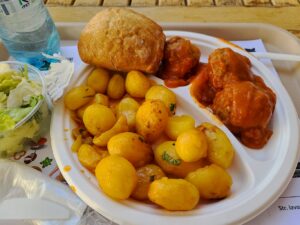
I visited three Autoservires in Romania. They were each incredibly cheap for a full plate of food. I paid less than $5 on each occasion, and the food is local. You won’t see many tourists here.
Autoservire food isn’t flashy. It’s not going to make a great shot for the ‘Gram. It’s cheap and local, though. And pretty good, too. These were the places I saw lines of local Romanians waiting to get food.
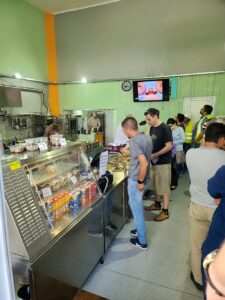
What about Street Food?
Street food doesn’t exist in Romania the same way as you will see in many countries. The closest thing to street eats will be the window stands where you can grab a quick ice cream, covrigi or other baked goods.
These window stands of food are also much less prevalent in smaller towns. That being said, you can fill up on a variety of Romanian pastries (sweet and savory) without spending much. In theory, you can spend about $5 and have food for the day. It’s not a balanced diet, but it is cheap food.
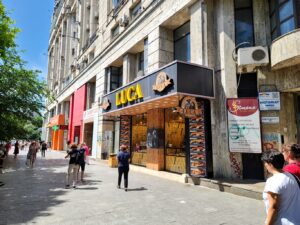
Leave the Tourist Bubble
I know this is mentioned in the general cheap eating tips above, but it is especially true in Romania.
Prices in tourist areas are much higher than elsewhere. What sets Romania apart from other European countries is that the prices in tourist areas really aren’t that bad. You can often find a beer or glass of wine in a main square for $3. Believe me, that is not happening in the center of Madrid, Munich or London.
In Romania, though, that $3 beer can drop to less than $2 if you leave the tourist bubble. You might only have to walk a few minutes. Suddenly, the tourists disappear and your nice, large dinner went from $15 to less than ten bucks.
Eating in Romania is cheap in most places. A teensy bit of effort can lead you to ever cheaper food!
Eating as a Tourist in Romania
Eating as a tourist in Romania does not come without challenges. If part of your travel plans include eating and enjoying local food in local establishments, this can require a little extra effort.
Romania is not unique in this sentiment. As tourists, it is often a challenge to escape the areas in which we find ourselves. The very sites that attract us to an area have everything we need: attractions, accommodation, shops, restaurants, etc.
To successfully navigate the tourist bubbles in Romania and eat locally, plan on doing some walking. That’s the simplest method to find local eats. Leave the historic, touristic area.
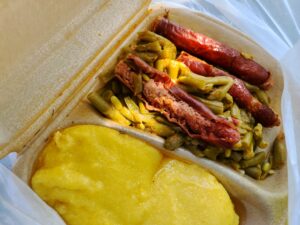
The most popular tourist destinations in Romania are also very popular for domestic tourism. A lot of these places, especially during pandemic times, are extremely reliant on domestic tourism.
How does domestic tourism affect what you eat as a foreign tourist?
Restaurants in high traffic areas are more likely to cater to what the bulk of their customers want. From my time in Romania, I can confirm that the local population is not looking for their local cuisine.
Romanians love Italian food. Well, we all love Italian food, right? Of course.
The tourist areas in Romania are flooded with Italian restaurants, though. Even when a restaurant isn’t specifically an “Italian Restaurant,” the menus frequently suggest otherwise.
Without a doubt, I saw more Italian food in Romania than anything else. By far. Clearly, domestic tourists in the country want to eat something different. Don’t take this as criticism – it makes perfect sense.
What this means for foreign tourists in Romania is that traditional, local food isn’t always abundant in popular areas. To be fair, many restaurants have a small section of local specialties. So, if you find yourself in an Italian restaurant against your will, look for the menu section that says something along the lines of ‘traditional’ or ‘Romanian.’
If you have the time, walk away from the tourist areas and find a busy restaurant or even a busy bar. If locals are there, you’ll be in good hands.
At the very least, stick to traditional restaurants in tourist areas. The prices are higher than they should be, but at least you can get an idea of local eating in Romania.
When the time comes and you’re too hangry to continue searching, take solace in the fact that you can eat good food in Romania for a good price. Find that ‘traditional’ section of the menu.
Prices/Cost Examples
If you’ve read this far, you will know that Romania is a fairly cheap place to eat. Similar to most places in the world, cities and tourist areas are more expensive. Tourist areas in cities are even more expensive. The largest city – in this case, Bucharest – is generally home to the most expensive eats.
Cheaper food in cities is found away from tourist attractions, and cheap food is abundant in smaller towns and rural areas.
However, what is expensive in Romania is going to be cheap for a lot foreign visitors. This is a win for you, and this is a win for local restaurants. You won’t break the bank dining out every night.
Here are some prices I paid for food and drinks in Romania (in 2022, in approx. USD):
- Domestic Beer: $2
- Craft Beer: $4-6
- Doner: $4.50 (my go-to cheap, quick eat abroad)
- Traditional Meal w/beer: $8-12 (in tourist center)
- Traditional Meal w/beer: $4-5 (outside tourist area)
- Whole Pizza: $5-10 (enough for two people)
- Covrigi: $0.50
- Romanian Fast Food: $4.50 (a ton of food)
- Mici (tourist restaurant): $6-7
- Mici (local spot): $3.50
Drinking in Romania
Romania has a long history of drinking, and the foreign influences are apparent in the booze, too. Local beer is basic (but improving rapidly), spirits are strong and representative of traditional culture and it is an underrated Old World wine producer.
Wherever you are in Romania, you will see that drinking is a big part of the cuisine.
Wine
Romania has a long history of winemaking, one of the oldest in the world. It is not on the same level of notoriety and production as France, Spain, Italy or other famous wine-producing countries, but the same climate and geography that yields a bountiful agricultural output is great for wine, too.

Romania’s wine production is growing. Current production places it 4th or 5th in Europe and 10th or 12th in the world (varying by source). That’s a lot of wine!
While Romanian wine receives far less attention than wine from places like Portugal, New Zealand or even Georgia (the country), the quality matches their production. The country is also an appealing choice for a more affordable, wine-focused travel destination.
My knowledge of beer is far greater than that of wine, but I can confidently report that Romanian wine is good. It is inexpensive, and it deserves more attention than it receives. When you’re in Romania, sample the local product for a pleasant surprise.
Romanian Liquor
Did you know that Romania is one of the top two producers of plums in the entire world? No, of course not. There’s no need to have this information in your brain.
The good news is that this is true. Romania’s climate is great for growing plums! An overwhelming majority of these plums are not eaten, though.
Where do they go? Liquor!
Romania’s two most popular spirits are tuica and palinca. These are different types of brandy. Tuica is strictly a plum brandy, while palinca is often plum-based but can be derived from other fruit.

Tuica is the de facto national spirit of Romania. Although palinca is also widespread, its roots are Hungarian and, within Romania, Transylvanian.
I enjoy brandy, and I have tasted varieties of brandy from several countries in Europe. However, my palate is not especially developed with respect to brandy, and most of these taste quite similar to me.
That’s not to say I dislike any of them. In fact, some are pretty good. Whether it is rakija, chacha, raki or tuica, they are all fairly similar.
Before anyone becomes upset, I am not saying these are exactly the same.
I will say that Romanian brandy is strong. Brandy consumption is more prevalent in rural areas where home distillation is common. This is a spirit to sip, so don’t try to keep up with locals.
Make sure to try some tuica and palinca in Romania! It’s good. Sip it responsibly with a snack or before your meal.
Beer
Domestic beer in Romania is fine. Like most Big Beer around the world, there isn’t a lot of variety between major brands. It’s not exceptional by any stretch, but it’s a hell of a lot better than Big Beer in the United States.
Basic beer in Romania pairs well with a hearty meal of traditional food. Best of all, beer prices are reasonable.

Craft beer in Romania is growing in popularity. Breweries are popping up across the country, and they are producing some great beer. Craft beers are more expensive but remain more affordable than craft brews elsewhere.
The Hangry Backpacker’s Guide to Beer in Romania is coming soon!
Hangry Backpacker Tips
- Tipping is weird. A lot of information out there says to round up or tip 10% if service is great. Well, service is extremely hit-or-miss in Romanian cities. Rounding up 5 or 10 Lei is generally acceptable. Maybe tip up to 10% if you’re with a large group or eating somewhere nicer.
- Request your bill at least 10 minutes before you plan to leave a restaurant. Quality of service will vary, of course, but ask for your check early unless you want to sit for ages trying to catch a server’s attention.
- One more thing: don’t pronounce the ‘i’ or other vowels on the end of words, unless you want a funny look from locals. For example, covrigi is pronounced co-VREEJ, and mici is pronounced MEECH.
Romanian food offers insight into the country’s history and culture. Better than that, and most importantly for hungry travelers, the food is good.

Travel destinations in Europe with affordable food are becoming fewer and farther between. What sets Romania apart from others is that you can sample a traditional culture – one that is very much alive in the 21st Century – and you can experience that culture through food.
Romanian food is not flashy or pretentious. It is practical, representative of the people. And again, it’s good.

Thank you for this, it will come really useful when we got to Romania next month. As someone who has eaten Pizza in 7 continents, the commentary on Pizza made me grin.
Happy to hear it! Certainly some good pizza to enjoy in Romania!
Next time you visit Romania, make sure you enjoy the other variety of sarmale, which, to my opinion, are more traditional (in the sense that they are historically older) than the sour cabbage ones: the ones wrapped in vine leaves. They are smaller (sometimes as small as a lady`s pinkie), with a base of mixed veal and pork – therefore less fatty and more appropriate for people who cannot eat fatty foods or are less inclined to, or for warmer seasons. The taste is to die for, due to the mix of meats and the spices used. They are usually served with polenta and peppers (fresh or pickled, depending on the season). I suspect the recipe is a local adaptation of some rolls in the Turkish and Middle Eastern cuisines, where I found vine leaf rolls filled with various veggies and rice. None of them comes even close to these sarmale. The vine leaf sarmale are typical to the Moldova and Muntenia regions, particularly popular in Moldova (also popular for its ”plăcinte”/pastries and its sour soups).
Great advice! I was able to try a few the variety with grape leaves, which was surprisingly much different. Not sure if I have a favorite, though. Both are excellent! Romanian food is very underrated. It’s so good!